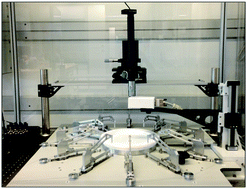当前位置:
X-MOL 学术
›
Soft Matter
›
论文详情
Our official English website, www.x-mol.net, welcomes your
feedback! (Note: you will need to create a separate account there.)
Characterization and modelling of Langmuir interfaces with finite elasticity
Soft Matter ( IF 2.9 ) Pub Date : 2017-07-21 00:00:00 , DOI: 10.1039/c7sm01100h Martina Pepicelli 1, 2, 3, 4 , Tom Verwijlen 5, 6, 7 , Theo A. Tervoort 1, 2, 3, 4 , Jan Vermant 1, 2, 3, 4
Soft Matter ( IF 2.9 ) Pub Date : 2017-07-21 00:00:00 , DOI: 10.1039/c7sm01100h Martina Pepicelli 1, 2, 3, 4 , Tom Verwijlen 5, 6, 7 , Theo A. Tervoort 1, 2, 3, 4 , Jan Vermant 1, 2, 3, 4
Affiliation

|
Interfaces differ from bulk materials in many ways, one particular aspect is that they are compressible. Changing the area per molecule or per particle changes the thermodynamic state variables such as surface pressure. Yet, when compressing to high surface pressures, dense packing of the interfacial species induces phase transitions, with highly structured phases, which can display elastic or strongly viscoelastic behaviour. When these are deformed, in addition to the changes in the surface pressure, extra and deviatoric stresses can be induced. The traditional tool to study the phase behaviour of monolayers is a rectangular Langmuir–Pockels trough, but as both the area and shape of the interface are changed upon compression, the interfacial-strain field in this instrument is mixed with a priori unknown amounts of dilatational and shear deformations, making it difficult to separate the rheological and equilibrium thermodynamic effects. In the present work, the design of a radial trough is described, in which the deformation field is simple, purely dilation or compression. The possibility to now independently measure the compressional properties of different strains and the development of an appropriate finite strain constitutive model for elastic interfaces make it possible to interrogate the underlying constitutive behaviour. This is shown here for a strongly elastic, soft glassy polymer monolayer during its initial compression but is easily generalised to many viscoelastic soft matter interfaces.
中文翻译:

具有有限弹性的Langmuir界面的表征和建模
界面在许多方面与散装材料不同,一个特定方面是它们是可压缩的。改变每个分子或每个颗粒的面积会改变热力学状态变量,例如表面压力。但是,当压缩到高表面压力时,界面物质的密集堆积会引发具有高度结构化相的相变,这些相变可表现出弹性或强粘弹性的行为。当它们变形时,除了表面压力的变化之外,还可能引起额外的和偏斜的应力。研究单分子层相行为的传统工具是矩形的朗缪尔-普克尔斯(Langmuir-Pockels)槽,但是由于压缩后界面的面积和形状都会发生变化,因此该仪器的界面应变场与先验混合未知数量的膨胀和剪切变形,使流变和平衡热力学效应难以分开。在当前的工作中,描述了径向槽的设计,其中变形场是简单的,纯粹是膨胀的或压缩的。现在可以独立地测量不同应变的压缩特性,并为弹性界面开发适当的有限应变本构模型,从而有可能探究基本的本构行为。这里显示的是强弹性,柔软玻璃态聚合物单层的初始压缩过程,但很容易推广到许多粘弹性软物质界面。
更新日期:2017-09-13
中文翻译:

具有有限弹性的Langmuir界面的表征和建模
界面在许多方面与散装材料不同,一个特定方面是它们是可压缩的。改变每个分子或每个颗粒的面积会改变热力学状态变量,例如表面压力。但是,当压缩到高表面压力时,界面物质的密集堆积会引发具有高度结构化相的相变,这些相变可表现出弹性或强粘弹性的行为。当它们变形时,除了表面压力的变化之外,还可能引起额外的和偏斜的应力。研究单分子层相行为的传统工具是矩形的朗缪尔-普克尔斯(Langmuir-Pockels)槽,但是由于压缩后界面的面积和形状都会发生变化,因此该仪器的界面应变场与先验混合未知数量的膨胀和剪切变形,使流变和平衡热力学效应难以分开。在当前的工作中,描述了径向槽的设计,其中变形场是简单的,纯粹是膨胀的或压缩的。现在可以独立地测量不同应变的压缩特性,并为弹性界面开发适当的有限应变本构模型,从而有可能探究基本的本构行为。这里显示的是强弹性,柔软玻璃态聚合物单层的初始压缩过程,但很容易推广到许多粘弹性软物质界面。











































 京公网安备 11010802027423号
京公网安备 11010802027423号